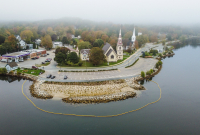Support strong Canadian climate journalism for 2025
In addressing the housing crisis, affordability and sustainability are sometimes cast in opposing roles.
But in Liverpool, a co-operative housing model is seeking to combine the two.
Queens Neighbourhood Co-operative Housing (QNCH) is planning 100 units of affordable passive housing for Queens County in southwestern Nova Scotia, with a 26-unit development in Liverpool to start.
The co-op is hoping to meet an increasingly desperate need for affordable rental housing in the county, while also showing how affordable housing can meet climate-friendly standards for efficiency and renewable energy.
“It's like the stars and the moon have aligned for us with people, programs, land,” says QNCH president Patti Pike. “It's been remarkable.”
QNCH came out of Queens Care Society, a seniors’ advocacy group that started in 2015 to provide local seniors with transportation and assistance to age in place.
Recognizing that aging in place also means having a place to live, the society began looking into housing, and while working with Earl Mielke of Inclusive Homes Consulting, approached the Region of Queens Municipality, which suggested potential sites in the region for co-op housing projects.
The first project, on Lawrence Street in Liverpool, will include 16 one-bedroom, eight two-bedroom and two three-bedroom units organized in two L-shaped, two-storey buildings around a central courtyard, with green space and community gardens.
While the development targets seniors, and prioritizes accessible design, it will also have a mix of residents, including young people and families.
Mielke says though having the development built according to the passive design principle is more expensive upfront, it pays off in the long run by keeping utility costs low, while also tapping into funding streams that reward sustainability.
This means addressing how buildings use energy.
“We’re implementing [passive design principles] to significantly reduce or completely eliminate the buildings’ reliance on fossil fuels,” says architect Molly Merriman, with Passive Design Solutions, the company tasked with the project’s design.
In the Liverpool development, this entails a super-insulated building envelope — the walls, roof and foundation — as well as triple-glazed windows and an airtight envelope assembly; all of which allow for mechanical heating and cooling systems that are themselves highly efficient, in addition to a design that also includes on-site solar.
This results in low or no power bills, says Merriman — and more comfortable houses.
While some people associate this approach with an elitist kind of development, Merriman says it’s showing promise as a way to address the housing crisis, as demonstrated by Passive Design Solutions’ other projects including multi-unit affordable housing builds with Adsum House and the Affordable Housing Association of Nova Scotia in the HRM.
“It feels like it's the only way forward, really,” says Merriman. ‘It’s showcasing that this design approach is not only possible but actually is, in itself, one of the reasons for the project’s affordability and long-term viability.”
In the near term, Patti Pike says the hope is to break ground on the Liverpool development in August or September, and to have people living in the units in two years’ time. Ultimately, QNCH plans to build 100 units of housing over three sites in the region.
With a current housing shortfall of nearly 400 units in the county — and rents that have doubled over the pandemic — proponents say it’s particularly important this first development be successful, as a demonstration that this approach can work.
Mielke says this could have implications for other small and rural communities looking to the co-op model as a solution to the housing crisis.
“Co-op is all about affordable housing. Developing affordable housing can happen in rural areas, right, not just in big cities,” he says.
But Pike says it’s thinking of the people in Queens County in need of housing — like the seniors who currently face coming home from hospital to homes with no running water — that’s the most motivating factor.
“We have a vision of seeing people move to this community where they're safe, and they're warm, and they can afford to live outside of paying rent — that's what keeps us going.”
This story is being shared by the Climate Story Network, an initiative of Climate Focus, a non-profit organization dedicated to covering stories about community climate solutions.






Comments
See, it's not the free market providing affordable homes, it's locals looking forward and filling a need and coop housing for anyone is a bonus.
Great story, on all fronts!
Passive (solar) housing design should have been adopted countrywide about five or six decades ago and co-op housing, as the article says, is one way to provide more truly affordable housing for all ages of people by removing the profit margin from construction costs. My decades of experience in construction has shown me that very few architects, building contractors, house designers or their clients have any knowledge of the principles of passive building design. Almost all housing is designed and built in this country without any consideration of these principles or any consideration of weather conditions (i.e. wind and solar patterns and details) affecting the future dwelling or dwellings.
I would like to see more articles written about both passive design principles and techniques and co-op housing.